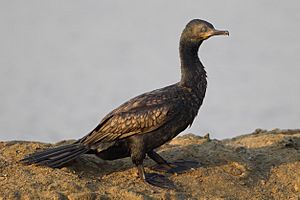Indian cormorant facts for kids
Quick facts for kids Indian cormorant |
|
|---|---|
 |
|
| In non-breeding plumage at Laem Pak Bia, Petchaburi, Thailand | |
| Conservation status | |
| Scientific classification | |
| Kingdom: | |
| Phylum: | |
| Class: | |
| Order: | |
| Family: | |
| Genus: |
Phalacrocorax
|
| Species: |
P. fuscicollis
|
| Binomial name | |
| Phalacrocorax fuscicollis Stephens, 1826
|
|
The Indian cormorant or Indian shag (Phalacrocorax fuscicollis) is a type of cormorant. These birds are mostly found near rivers and lakes in the Indian subcontinent. Their home range stretches from Sind in the west to Thailand and Cambodia in the east. Indian cormorants like to live in groups. You can easily tell them apart from the similar-sized little cormorant. Look for their blue eyes, small head, and a long, thin bill with a hooked tip.
Contents
What Does the Indian Cormorant Look Like?
This bird is a medium-sized cormorant. Its feathers are a bronze-brown color with black patterns on its back. It does not have a crest (a tuft of feathers on its head). Its head is small and slightly pointed. The bill is long and narrow, ending with a hooked tip.
The Indian cormorant has bright blue eyes. The skin around its eyes is yellow when it's not breeding. During the breeding season, these birds grow a small white tuft of feathers near their ears. Some birds might have a white throat. However, this white area is only below their mouth, unlike the much larger great cormorant. Male and female Indian cormorants look very similar. Young birds and adults not in breeding season are usually browner.
Where Do Indian Cormorants Live?
Indian cormorants love to fish together in groups. They are found in rivers and large wetlands across peninsular India. You can also find them in the northern part of Sri Lanka. They sometimes live in estuaries (where rivers meet the sea) and mangrove forests. However, they do not live on the open coast.
These birds breed in specific places. They often join mixed groups of other bird species to raise their young. Their range extends northeast into Assam and eastward into Thailand, Myanmar, and Cambodia.
Reproduction and Life Habits
The breeding season for Indian cormorants usually runs from July to February. The exact timing depends on how much rain falls and the water conditions. For example, in northern India, they breed from July to February. In Sri Lanka, they breed between November and February.
Their nest is a platform made of twigs. They build these nests in the forks of trees. These trees are often partly underwater or grow on islands. Many nests are built very close to each other. They often nest near other Indian cormorants, storks, or other waterbirds. These colonies can be very dense, with nests stacked in several layers. A female usually lays three to five eggs. The eggs are bluish-green and have a chalky feel.
Indian cormorants catch fish by diving underwater for short periods. A group of these birds will often fish together. They form a wide line to drive fish into a corner, making them easier to catch.
See also
 In Spanish: Cormorán indio para niños
In Spanish: Cormorán indio para niños



